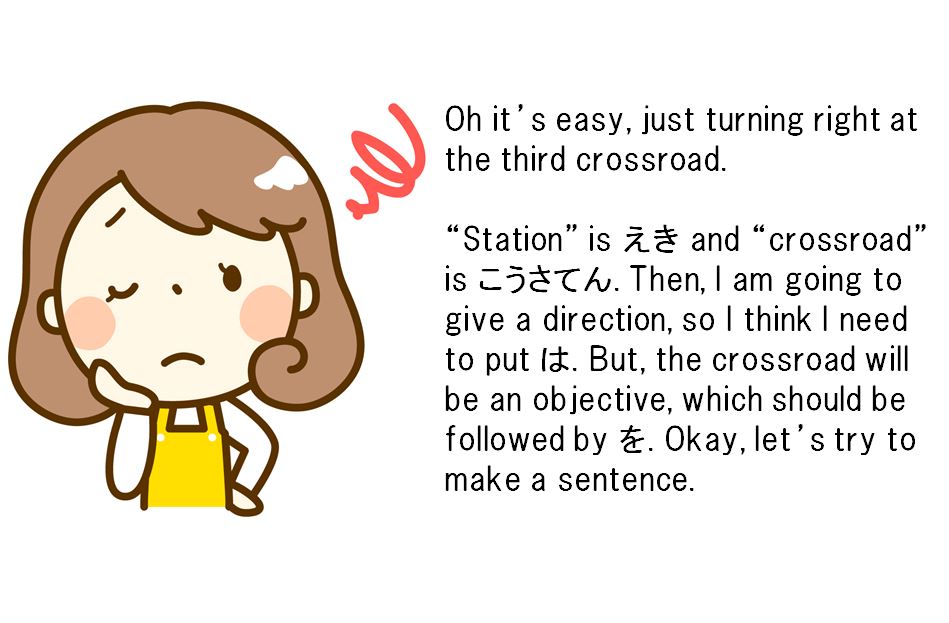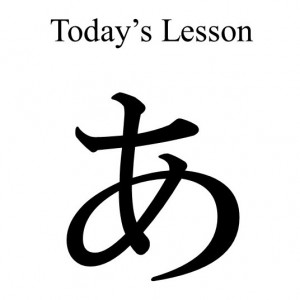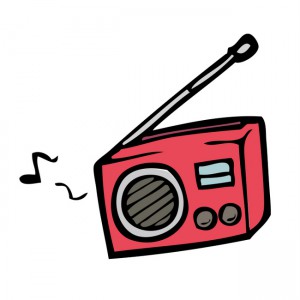「近くの駅までの道を教えてもらえませんか?」
If a Japanese person suddenly were to ask you for directions, would you be able to guide him or her to the correct location? If you thought it was difficult before; you don’t have to worry about it now. The Read-Aloud method will enable you to enjoy conversations in Japanese without stress. Consider why the question above might be difficult. Is it the speed with which you would need to respond? Or the accuracy? If you were given 10 minutes, we think you could completely manage it. However, at the time, your brain might be something like the above picture.
You certainly know the vocabulary and the grammar. However, it might have taken some time to combine the words based on the grammar in your brain. The Japanese lessons; Read-Aloud method will change your mental process from “I know Japanese” to “I can use Japanese”. By continuously listening to Japanese and reading out loud, you can learn how to combine sounds to produce proper sentences at a high speed. This will help you acquire usable, general language ability.
Japanese Lessons: Read-Aloud Method
The Japanese lessons consist of four elements; listening, repeating, reading out loud, and shadowing. We will explain how to proceed in great detail in order for you to be able to just follow along and maximize the effectiveness of your study time. The article is a little lengthy, but please bear with us.
Learning Materials
We will be providing all learning materials for the Japanese lessons, such as listening materials, scripts and translations. There are four types of audio files to help you with this method; slow speed, slow speed with pauses, natural speed and natural speed with pauses. If you would like to know more about the materials, please check the followings:
Table of Contest
- Listening
- Repeating with Script
- Reading out Loud
- Repeating without Script
- Shadowing
- Repetition of Cycle
*You don’t have to memorize the whole process. You can check one of the following explanations while proceeding with the Japanese lessons.
*We mentioned the specific number below. Although you don’t have to be too strict, we recommend you to keep to them as much as you can.
1. Listening
First, you are going to listen to an audio file over and over without both the script and the translation. During that time, you don’t have to understand all the sentences. By listening over and over, you will come to recognize some of them. Please continue for several days until you understand it as much as you can. If you felt you could not understand it at all, you may check the script. However, the purpose of the listening part is to reconcile what you have can understand by listening (auditory information) and what you can understand by reading with the script (visual information). Thus, once you have checked it, please move back to continuously listening until you understand it as much as you can.
Secondly, you are going to confirm whether your understanding is correct or not. The best way is to dictate what you have understood and go over it with the script line by line. However, it may be too difficult. If that is the case, you can proceed with this by repeating the audio file line by line and confirm whether what you have repeated is correct or not with the script. Either way, please go over each sentence carefully.
Finally, you will try to fully understand the script. Please be familiar with all the vocabulary, the grammar and the sentence patterns by utilizing the translations, the explanations and your dictionary before moving to the next part; Repeating.
2. Repeating with Script
You are going to use the audio file with pauses and then exactly repeat the audio file for each sentence with the script about five times. The “with pauses” type is designed for playing one sentence or one phrase and pausing for a few seconds. During the pauses, you can repeat as shown below.
| Audio | こんにちは。 | Pause | 今日は暑いですね。 | Pause | これからどこに行くの? |
|---|---|---|---|---|---|
| You | Listening | こんにちは。 | Listening | 今日は暑いですね。 | Listening |
One important thing here is to repeat the sentences in their entirety. For example, the audio file played 「暑いですね」 and you said 「暑いですよね」. There is almost no difference, however, please try to repeat the sentences exactly as they are spoken on the audio file. It will make a big difference.
3. Reading out Loud
You are going to read the script out loud 10 to 15 times. Please try to imitate the audio file you listened as much as possible and be conscious of the meaning of the words and the structure of the sentences. That way, you can remember Japanese native expressions in your brain, which will boost your speaking abilities afterward.
4. Repeating without Script
You are also going to use the audio file with pauses and then exactly repeat each sentence without the script. If you can repeat them smoothly, please try three times. If you had difficulty repeating without the script, please don’t hesitate to use the script as you did in the previous part. While you are proceeding with these Japanese lessons, you will be able to manage it.
[adsense]
5. Shadowing
You are going to use the audio file. The origin of the name; shadowing, comes from the method of the practice by which a learner follows an audio file two or three seconds later than the actual recording time. Please try shadowing five times without the script as shown below.
| Audio | こんにちは。今日はいい天気ですね。これからどこに行くの? |
|---|---|
| You | “ “こんにちは。今日はいい天気ですね。これからどこに行くの? |
It is likely that a learner who has not gotten used to these Japanese lessons cannot do shadowing well. If that is the case, please don’t hesitate to use the script. Again, while you are proceeding with these Japanese lessons, you will be able to manage it and get better at it. The important thing here is to try to follow the audio file in its entirety.
6. Repetition of Cycle
After you have finished all of the audio files by using this method you will go back to the beginning and use the first audio file again and repeat the cycle. From the second cycle, you can skip the Listening part because you are already aware of the sounds and the sentences.
Instead, please try repeating without the script first. If you could repeat all the sentences correctly, it means that you have completed these Japanese lessons and your Japanese proficiency has dramatically improved. If you couldn’t, please proceed with the repetition of the cycle until you can manage repeating without the script.
Conclusion
You may be surprised by the amount of the repetition in these Japanese lessons. However, by making a lot of surveys and studying the process of trial and error over and over, we eventually reached the conclusion; this method is the best to acquire general language ability. The good aspect of a lot of repetition is that you can concentrate on your learning. Unfortunately, there are cases that some of learners are distracted by wondering if this way of learning Japanese is really good for him or her and then watching several videos on YouTube or briefly reading some guide books. That is not bad. However, if you focus on this read aloud method, although it takes a few months and it can sometimes be boring, you are certainly going to acquire the ability to speak and comprehend. Just like a person who exercises and does muscle training will undoubtedly become stronger and fitter. Please give it a try.
Recommended Links
- Fairy Tales and Short Stories with Easy Japanese (JLPT N4)
- Wasabi Japanese Radio Podcasts (JLPT N3)
- Complete Roadmap: How to Speak Japanese
- Wasabi Learning Community on Facebook





